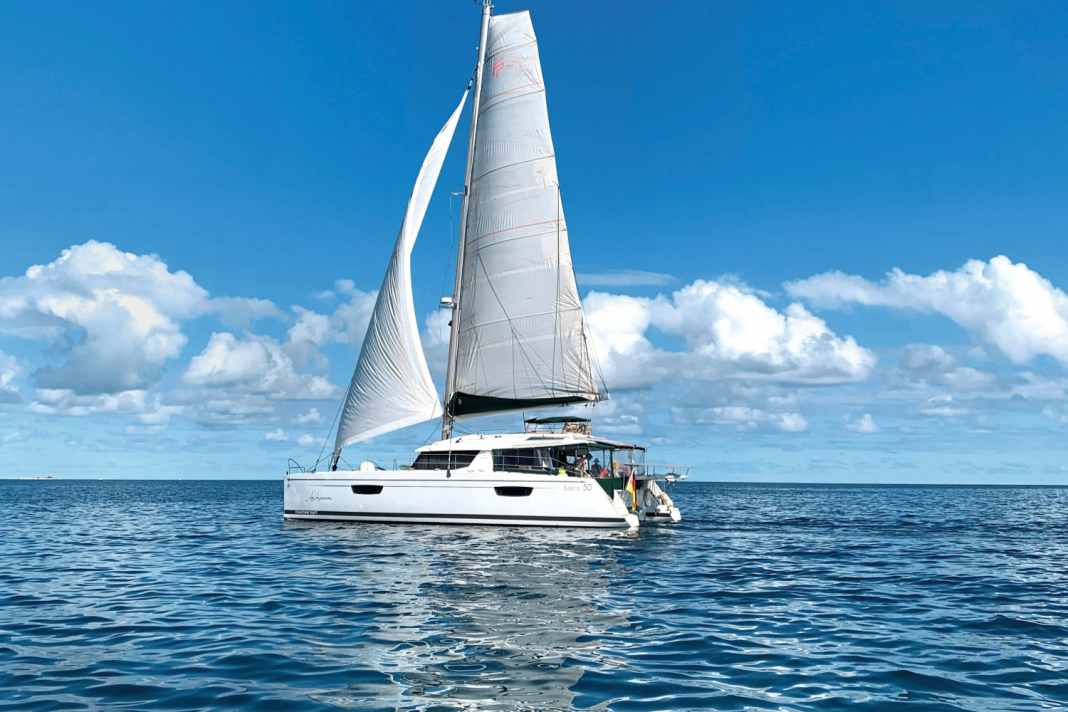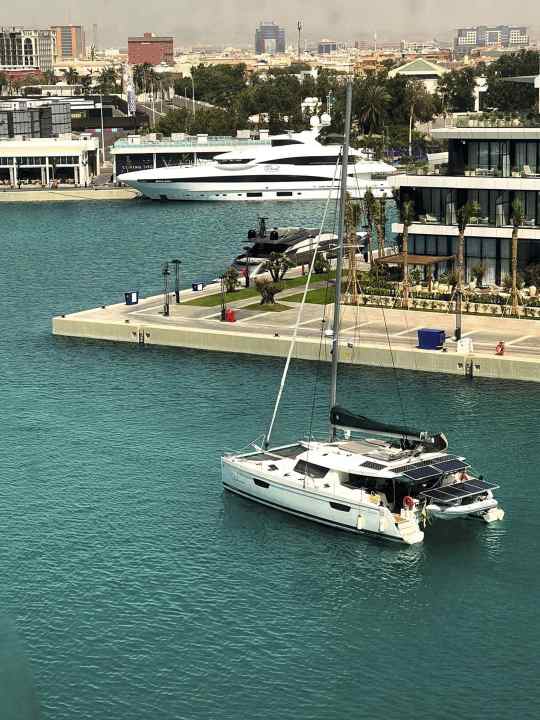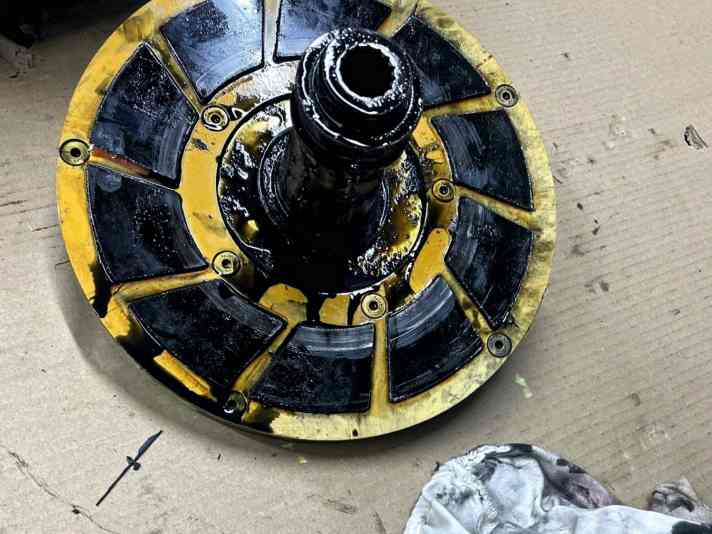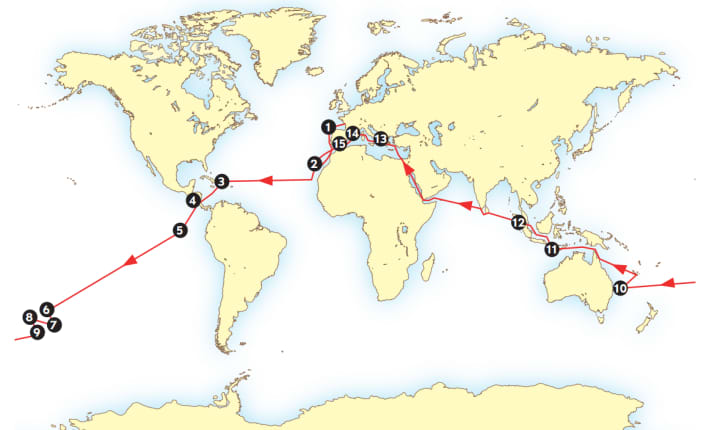Sailing around the world: Around the world with the E-cat - the blue water family takes stock
Fabian Boerger
· 20.11.2024






A circumnavigation is always a journey into the unknown. The Lohmüller family has explored the unknown in two ways: firstly, the four of them have travelled to almost 40 countries around the globe on their "JaJapami", a Saba 50 from Fountaine Pajot, since 2017. They also wanted to travel as sustainably as possible. They dispensed with the classic marine diesel engine and opted for an electric propulsion and supply system. We spoke to them about this after their arrival in Tenerife.
YACHT: You sailed around the world for seven years. How did you come up with the idea of doing this purely electrically?
Jana: Well, the first idea was to sail around the world. The timing was good because the children were still small. And the second idea was to always be sustainable.
Jan-Dirk: It all started in 2015, when we lived in Düsseldorf, very close to the boat show. Sometimes we were there every day. This gave us the idea that a boat could also be equipped with sustainable and green electric motors.
Why was the idea of sustainability so important to you?
Jana: When you put a biologist and an engineer together, you tend to get something green. That has always been the case in our lives.
You finally decided in favour of a Saba 50. Why did you choose a catamaran?
Jana: It was always clear to us that we wanted family sailing. The living comfort is simply much better on catamarans than on monohulls. And to be honest: it's great sailing! Catamarans are also fantastically quiet at anchor.
When you put a biologist and an engineer together, you tend to get something green. That's always been the case in our lives."
You installed a drive and supply system from Oceanvolt back then. Why did you do this?
Jan-Dirk: Well, that was the only supplier that had a system like we wanted, ready to install and already installed in several hundred versions.
What does this system look like on board in detail?
Jan-Dirk: So, we have a 48-volt battery bank. This consists of twelve Super B batteries with 1,920 ampere hours. A converter is used to generate 12-volt current. Two lithium batteries are in reserve. Today, the batteries are mainly charged using solar energy. Our panels initially supplied 800 watts. But that wasn't enough for cooking, heating water and washing clothes with electricity. We have now installed more than 3,000 watts. That's enough for our daily needs, i.e. for a four-person household with all the comforts. Then there is our water maker. This requires 2.2 kilowatts, which are generated entirely by the solar panels when the sun is shining brightly.

And when the sun isn't shining?
Jan-Dirk: We have a 21-kilowatt generator from Fischer Panda on board, an AGT 22 000.
So you're not completely independent of fossil fuels, right?
Jana: That's true. However, we rarely used the generator. We had to use it in Asia. There was hardly any wind there.
Jan-Dirk: Otherwise, we use as much solar energy as possible.
A circumnavigation with an electric drive is still rather unusual at the moment. Your project was a pioneer in 2017. How did that make itself felt?
Jan-Dirk: Initially, we were in very close contact with the companies. For example, when the boat was launched in La Rochelle, Fountaine Pajot and Oceanvolt carried out numerous tests in the first month. Everyone seemed to be very impressed with the system.
Jana: They were also accommodating when it came to the purchase. You could tell that everyone wanted the project to be successful. But then problems arose.
Also interesting:
What had happened?
Jan-Dirk: It was day three of our trip and there was very little wind in the Bay of Biscay. The engine was running slowly. At the same time, we had an unpleasant swell. Quite suddenly, a heavy wave hit us from astern. That must have been the moment when the saildrive's gearbox was pulverised. It was then replaced in Portimão - but not the engine, which had suffered bearing damage. So the boat had to come ashore again in Tenerife.
Jana: We then realised that interest in us on the part of the supplier companies was gradually dwindling.
Problems with the supply system
So it was a rather unfortunate start to your project. What happened afterwards?
Jana: After that, the drive worked smoothly. But when we arrived in the Caribbean, the supply system failed.
Jan-Dirk: A single cell of a battery broke. It was a production error in a batch of Super-B - and we had one of them on board.
Jana: And from Panama onwards there were problems with the generator.
Jan-Dirk: It is only designed for charging classic lead-acid batteries. Charging is controlled via the resistance in the batteries. The problem is that lithium batteries have a constant resistance up to 99.9 per cent. That is why this type of charge control does not work. As a result, the generator was always running at full load without overrunning to cool down - and frequently overheated.
How did you get to grips with the problem?
Jana: It took us a very long time to get to the bottom of the problem. Only then were we able to set about solving it.
Jan-Dirk: In the Panama Canal, we first left the engine flap open and removed the insulation. This cooled the engine slightly. We didn't have a control unit back then. We only got one in Tahiti. The owner of a Slyder catamaran with an Oceanvolt system had developed it himself.
Jana: The problems continued. We lost a propeller between Panama and Galapagos. We still can't explain how this could have happened. We had to wait six weeks for a replacement - another unplanned stop.
The pandemic is forcing a break
That sounds like non-stop trouble. Or is the impression deceptive?
Jana: Yes, that's deceptive! The Galapagos Islands were followed by the Marquesas. It was great there. We then explored the Tuamotus, followed by Tahiti and Papeete. But then came the Covid pandemic. That's when we were in Rangiroa.
How did you fare there?
Jan-Dirk: We had to go into lockdown for six weeks in February 2020. This was followed by the second wave and the next lockdown. In total, we spent two and a half years in French Polynesia.
Jana: That was never the plan. Rather, we had estimated three years to sail from Europe to Australia. We wanted to sell the boat there and then return. But we only arrived in Brisbane in December 2021.
Why didn't you sell the boat there after all?
Jan-Dirk: That's what we wanted. Initially, we refurbished it in a shipyard. But then the plan to sell it fell through - for various reasons. For example, we would have had to import it into the country for 20 per cent of its value before we could sell it.
Jana: We therefore decided to return to Europe on our own keel.
You sailed to Australia for six years and returned to Europe within eleven months. Why such a rush?
Jana: Our money was running out and the children urgently needed to go to school. They are now almost teenagers and need friends of the same age.

We were optimistic from Australia onwards. But then we filled up with contaminated diesel - and the drama began again!"
On the return journey, the problems started all over again
How did the return journey go?
Jana: The e-system worked perfectly again. We started in New Caledonia and sailed along the Indonesian island chain. We were optimistic. But then we filled up with contaminated fuel - and the whole drama started all over again!
Jan-Dirk: In the end, we had to replace everything again. We repaired the water maker in Singapore and the generator in Malaysia.
Then you travelled to India and across the Red Sea to the Mediterranean. Why did you choose this risky route?
Jana: It was indeed not an easy decision. But we didn't have time to take the longer route around South Africa. We had to get home quickly.
Jan-Dirk: Of course we were tense, as Somali pirates were rumoured to be active again. But the passage went without a hitch.

Then you travelled through the Suez Canal into the Mediterranean. And even there you were not spared problems.
Jan-Dirk: That's right. On the way to Termini Imerese (in Sicily, editor's note) the engine finally broke down on the port side, directly behind the harbour mole. There was a short circuit caused by defective ball bearings, as we found out later.
Jana: From this point onwards, we sailed completely without an engine. It was an impressive feeling to move the large and heavy ship with only sails. When the wind dropped, we towed ourselves with the dinghy. That's how we reached Cartagena. The boat was taken to the shipyard there.
Then you crossed your course line before Gibraltar...
Jan-Dirk: Yes, exactly. We officially sailed around the world there on 26 September.
The balance sheet - experiment a success?
You write on your website that your trip was also an experiment. Looking back, what would you say: was it a success?
Jana: In Australia we reached a point where we thought: That's it! It was difficult for us to decide to sail home anyway. Nevertheless, it was fantastic in India, for example. The visits to the old cities in the Mediterranean were also impressive. To summarise: the highs were high, the lows were low.
Jan-Dirk: We now know the systems on board inside out. So I would definitely do it again.
Who wants a smelly, noisy diesel engine that constantly needs refuelling when you can have an electric motor that powers itself using solar energy?"
Despite the many breakdowns and repairs - travelling the world again with an electric drive?
Jana: Absolutely! We were so proud so often! We've been on Tenerife for four weeks now and the generator rarely runs. We run our entire household sustainably - mainly from solar energy. That's great.
What are the biggest weaknesses of the technology?
Jan-Dirk: Well, the only real weak point lies in the design of the Saildrives. They are connected directly to the engine without a clutch. In addition, the saildrive generation we tested was too weakly dimensioned.
Do you believe that electric drives for yachts are the future?
Jan-Dirk: Definitely!
What makes you so sure?
Jana: Quite simply, who wants a smelly, noisy diesel engine that needs constant refuelling when you can have a quiet electric motor that powers itself using solar energy?
Jan-Dirk: The motors are also completely maintenance-free. They require a little gear oil once a year. They are also extremely quiet and very powerful when manoeuvring. As the torque is applied from the first revolution, the propeller has a completely different effect. A diesel engine first needs 1,000 revolutions before it sets the boat in motion. That is an enormous difference. Then there is the recuperation option.
But you have to be able to rely on the engine, especially when travelling around the world. Aren't diesel engines the more reliable choice?
Jan-Dirk: That's not true. For example, we had major problems with our diesel generator, while the electric motors worked perfectly.

And your problems with the bearings?
Jan-Dirk: We should have simply opened the engines. Then we could have replaced the bearings ourselves. But we thought that was witchcraft. Until a young technician opened them up: "The system is so simple. It's just the rotor that turns. Everything else is fixed - apart from the bearings. These are the weak point. But you also have that with a combustion engine.
If it's so simple, why are there still so few boats with electric motors on the water?
Jan-Dirk: In principle, the system is suitable for mass production. You just have to install it in the right weight class. Our system with modified engine control settings and a clutch in front of the saildrives would be perfect. I think the topic will become bigger in the next few years.
You are now on Tenerife. What's next for you?
Jana: First of all, we need to clarify how to proceed with the "JaJapami". We're thinking about day charters. We are working on that.
Jan-Dirk: It would be ideal if we could find an electricity connection that is powered by renewable energies. That would set us apart from other providers. We want to offer our tours from the end of November.
Jana: We are also looking for new jobs - possibly in the field of renewable energies.
Good luck and thank you very much for the interview!
The route: a tour with breakdowns and a pandemic

- Biscay (July 2017) A shaft hits the propeller so hard that the saildrive gearbox is pulverised. It is replaced in Portimão.
- Tenerife (Oct. 2017) The boat has to be taken out of the water because the starboard engine also needs to be replaced.
- Caribbean (March 2018) Difficulties with the battery bank. One cell is broken. A replacement is eventually delivered to Sint Maarten.
- Panama (March 2019)The generator problems are increasing. It is constantly overheating. There are no lead and lag times for cooling. More solar power is installed on the Pacific side of the canal.
- Galapagos (April 2019) During the crossing, the cat loses a propeller for unknown reasons.
- Tahiti (September 2019) Further solar panels are installed.
- Tuamotus (Feb. 2020) The generator fails : The heat exchanger is clogged.
- Tahiti (December 2020) The generator is removed, overhauled and a timer is installed. This should prevent overheating from now on.
- French Polynesia (2021) As a result of the global coronavirus pandemic, the onward journey comes to a standstill several times.
- Australia (2022) The boat is refurbished for three months. Then the intended sale is cancelled. They sail home themselves.
- Indonesia (Sep. 2023) Components in the generator break down due to contaminated diesel. The watermaker also needs to be repaired.
- Singapore (Nov. 2023) The watermaker can be fixed. The generator is also being repaired in Malaysia.
- Sicily (Sep. 2023) The port motor stalls and causes a short circuit. The on-board system fails completely. Continue under sail.
- Spain (Aug. 2024) A shipyard can repair the engine damage.
- Gibraltar (Aug. 2024) "JaJapami" crosses its course: circumnavigation completed!
The "JaJapami"
- Model/shipyard: Saba 50/Fount. Pajot
- Total length: 14,95 m
- Width: 7,99 m
- Depth: 1,25 m
- Weight: 20 t
- Purchase price: 780,000 euros
The drive system
- Battery bank (48 V): 12 x 160 Ah
- Batteries: LiFePO4 batteries
- Solar power: 3.040 Watt
- Generator (Fischer Panda): 21 kW
- E-motors: 2 x 12-15 kW
- Propeller (Gori): 16.5 and 18 inch
- Gearbox: Saildrive

